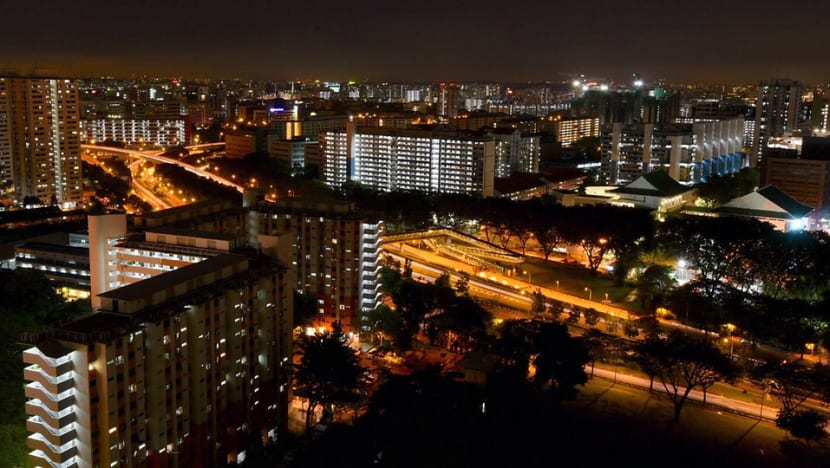More electricity retailers launch off-peak plans offering cheaper rates to Singapore residents
Under a time-of-use plan, residents who use electricity during off-peak hours instead of peak periods can save almost S$500 (US$388) a year.

A view of HDB flats at night. (File photo: Xabryna Kek)

This audio is generated by an AI tool.
SINGAPORE: More electricity retailers in Singapore are offering plans with less costly rates during off-peak hours, which analysts say could lead to even cheaper plans amid stiffer competition.
Under a time-of-use plan, residents can save almost S$500 (US$390) a year, slashing their bills by as much as a third.
Off-peak hours vary across different plans depending on the retailers, with some classifying them as 11pm to 7am and others from 9pm to 9am.
Geneco, Senoko Energy and PacificLight Energy currently offer such plans, while Keppel Electric launched their "weekend saver" time-of-use plan on Wednesday (Oct 1).
Tuas Power will start offering time-of-use plans to its customers in the first quarter of 2026.
Time-of-use plans became available in Singapore when the country opened up its retail electricity market in November 2018, allowing customers to choose their electricity supplier and price plan.
Residents who sign up are required to use a smart meter to track their daily electricity consumption at half-hourly intervals. Smart meters are set to be installed in all 1.58 million homes by 2026, with nearly 1.28 million already installed as of March this year.
MORE AWARENESS AMONG CONSUMERS
PacificLight, which offers two types of time-of-use plans, said signups for its 9-to-9 no-contract scheme have jumped three times this year compared with last year due to more awareness. Subscribers to the plan enjoy cheaper rates from 9pm to 9am.
"Consumers realise that if they want to look at more ways to increase their savings on electricity usage, they will be able to change their habits, shift their electricity usage to periods when the price point is lower,” said Ms Geraldine Tan, the company’s general manager of retail, renewables and imports.
“They have a lot of room to utilise their washing machines or other electrical appliances during that time period.”
Ms Tan said the company’s analysis of some consumers on the 9-to-9 plan showed they were able to shift about 70 to 80 per cent of their electricity consumption to off-peak hours.
“An average five-room flat household can save easily, let's say, more than S$30 per month,” she added.
“So, on an aggregate basis, they can (save up to) S$1,000 in comparison with a two-year fixed price plan.”
The company's other option, the Save While Sleeping plan, is a fixed 24-month plan that allows people to get 35 per cent off the regulated tariff during off-peak hours.
BALANCING SUPPLY AND DEMAND
Mr Michael Wong, chief operating officer of Tuas Power, one of the retailers planning to offer time-of-use plans, also noted that the wholesale electricity market in Singapore runs on “a half-hourly basis”.
Power generation companies must bid to sell electricity in the wholesale electricity market every half an hour.
"(This means) we need to project the consumption before the half hour, and then we need to plan for the generation to meet the demand of that particular half hour,” said Mr Wong.
“That demand forecast becomes very important. The accuracy becomes very important for us to optimise our generation.”
He told CNA that time-of-use plans can help balance electricity supply and demand, which will in turn help with Singapore’s aim for net-zero emissions by 2050.
As the country incorporates more variable energy sources like solar and wind power, their integration also places additional stress on the power grid.
Dr David Broadstock, a partner at energy-focused strategy and economic consultancy Lantau Group, said more plans offering consumers flexibility will be necessary in a future increasingly powered by renewable energy.
He noted that this will ease pressure on the energy system by distributing peak usage more evenly and avoiding concentrated demand surges.
With more retailers rolling out time-of-use plans, Dr Broadstock also said this could create price competition among firms to win customers.
“It's quite important that we have access to prices that can vary, because it will help encourage changes in behaviour,” he added.
“In order to reach a decarbonised future, the more options we have to do that in ways which place less pressure on the system, the better we'll all be in the long run.”
NATURAL GAS WILL REMAIN KEY
More than 90 per cent of Singapore’s electricity is currently generated using natural gas, according to latest figures released in July by the Energy Market Authority.
The country expects natural gas to remain an important part of the energy mix even as it seeks to decarbonise the power sector.
Singapore has just one liquefied natural gas (LNG) terminal at the moment, located on Jurong Island. It imports natural gas cooled into liquid form, which is more efficient and cost-effective to transport over long distances.
The terminal is built, owned and operated by the Singapore LNG Corporation (SLNG).
“Natural gas is the most viable fuel source to meet Singapore’s clean energy needs, due to its availability and much cleaner profile compared to other fossil fuels,” SLNG CEO Leong Wei Hung told CNA.
“While the Singapore government has taken steps to tap into solar energy, green electricity from regional power grids, and low-carbon alternatives, some of these will take some time to fully develop and become viable.”
According to the latest full-year figures, SLNG’s current terminal handled about 5.1 million tonnes per annum of LNG for the Singapore market in 2024, up 65 per cent from 2019.
Aside from being scalable to meet future demand, the terminal is also adaptable.
Mr Leong said that with some design changes, it can accommodate alternative fuels that Singapore has been exploring, such as ammonia and bio-LNG.
To further enhance the nation’s energy security, SLNG was given approval in 2023 to develop, own and operate the country’s second LNG terminal.
The company said then that it aims to have it operational by the end of this decade.





















